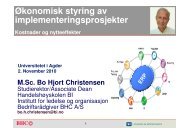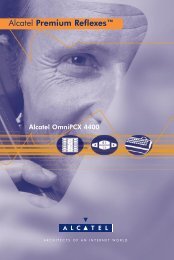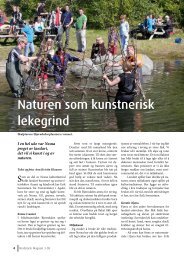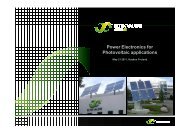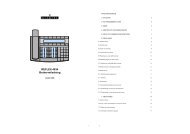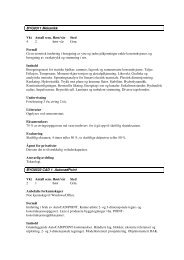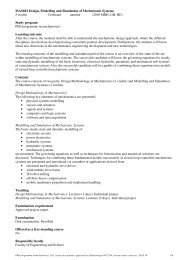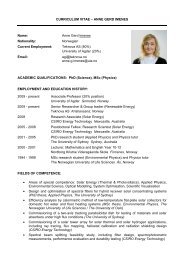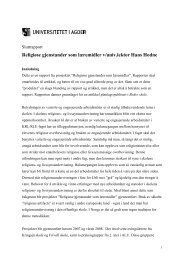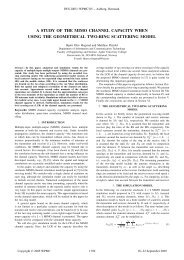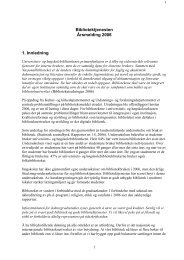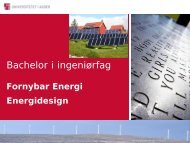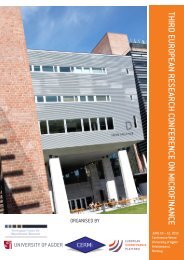A guide to solar cells using Elkem Solar Silicon (ESSâ¢)
A guide to solar cells using Elkem Solar Silicon (ESSâ¢)
A guide to solar cells using Elkem Solar Silicon (ESSâ¢)
Create successful ePaper yourself
Turn your PDF publications into a flip-book with our unique Google optimized e-Paper software.
A <strong>guide</strong> <strong>to</strong> <strong>solar</strong> <strong>cells</strong> <strong>using</strong><br />
<strong>Elkem</strong> <strong>Solar</strong> <strong>Silicon</strong> (ESS)<br />
Jan Ove Odden
Outline<br />
• The <strong>Elkem</strong> <strong>Solar</strong> process route and ESS compared <strong>to</strong> polysilicon<br />
from the Siemens technology.<br />
• Qualification of ESS as a new <strong>solar</strong> grade silicon product<br />
• Summary<br />
2<br />
Developing people - creating value<br />
22.06.2011
<strong>Elkem</strong> <strong>Solar</strong> – position in the value chain<br />
Si-metal<br />
Feeds<strong>to</strong>ck Ingot Wafer<br />
Celle Modul<br />
System/<br />
installasjon<br />
<strong>Elkem</strong> <strong>Solar</strong><br />
<strong>Silicon</strong> (ESS)<br />
Polysilicon from the<br />
Siemens process<br />
3<br />
Developing people - creating value<br />
22.06.2011
<strong>Elkem</strong> <strong>Solar</strong> <strong>Silicon</strong> ® production process<br />
with comprehensive value chains<br />
Recycling of ingot cuts<br />
Metallurgical<br />
<strong>Silicon</strong><br />
Slag<br />
treatment<br />
Leaching<br />
Solidification<br />
Post<br />
treatment<br />
Cus<strong>to</strong>merprocess<br />
Specialized products from side streams<br />
Market<br />
• In-house<br />
production only<br />
• Based on <strong>Elkem</strong>‘s<br />
core competencies<br />
• Three sequential purification steps designed <strong>to</strong><br />
reduce the level of impurities for critical elements<br />
• Largely based on <strong>Elkem</strong>’s core competencies in<br />
high temperature processes, process- and<br />
equipment design<br />
• Ingots cleaned<br />
and cut in<strong>to</strong><br />
bricks of ~10-15 kg<br />
• Quality control<br />
4<br />
Developing people - creating value<br />
22.06.2011
Production<br />
of polysilicon<br />
1) No recycling of STC<br />
Production of<br />
Metallurgical grade silicon (MG-Si)<br />
SiO 2 (s) + 2C(s) → Si(l) + 2CO(g)<br />
(Source: A. Schei et al., 1998)<br />
Generation of TCS from<br />
Metallurgical grade Si<br />
Reaction:<br />
Si(s) + 3HCl(g) → SiHCl 3 (g) + H 2 (g)<br />
TCS<br />
Separation of TCS by<br />
distillations<br />
Decomposition<br />
in<strong>to</strong> polysilicon<br />
Removes Boron as BH 3 and Phosphorus as<br />
PCl 3 and POCl 3<br />
Decomposition reaction, simplified:<br />
~1100°C<br />
4SiHCl 3 (g) → Si(s) + 3SiCl 4 (g) + 2H 2 (g)<br />
TCS<br />
(Source:<br />
CDI, www.chemicaldesign.com)<br />
STC<br />
5<br />
(Source: www.gt<strong>solar</strong>.com.com)<br />
Developing people - creating value<br />
22.06.2011
Energy payback time (EPBT) – Comparison - LCA<br />
1.8<br />
Energy payback time (years)<br />
1.6<br />
1.4<br />
1.2<br />
1.0<br />
0.8<br />
0.6<br />
0.4<br />
0.2<br />
0.0<br />
Siemens<br />
<strong>Elkem</strong> <strong>Solar</strong><br />
Siemens 2006 ESS 2010<br />
inverter<br />
mounting + cabling<br />
frame<br />
laminate<br />
cell<br />
ingot/crystal + wafer<br />
Si feeds<strong>to</strong>ck<br />
13.2% multicrystalline Si modules<br />
Schletter on-roof mounting<br />
2500 W inverter from ecoinvent 2.0<br />
performance ratio 0.75<br />
irradiation 1700 kWh/m2/year<br />
6<br />
Developing people - creating value<br />
22.06.2011
CO2 emissions depend on location and technology<br />
Comparison of direct related emissions of CO 2 equivalents (in MT)<br />
for different processes producing 6000 MT SOG-Si<br />
900000<br />
800000<br />
700000<br />
600000<br />
MT CO2<br />
500000<br />
400000<br />
300000<br />
200000<br />
100000<br />
0<br />
TCS without<br />
recycling<br />
TCS with<br />
dirty<br />
recycling<br />
TCS with<br />
clean<br />
recycling<br />
*) The German electricity mix is used as a base value when otherwise is not stated<br />
**) Note that this comparison accounts for new SOG-Si producers<br />
<strong>Elkem</strong> <strong>Solar</strong><br />
<strong>Elkem</strong> <strong>Solar</strong><br />
(Norwegian<br />
electricity<br />
mix)<br />
* 1700 kWh/m2/yr<br />
TCS nonrecycle<br />
(coal-based<br />
el mix)<br />
7<br />
Developing people - creating value<br />
22.06.2011
Main difference between ESS and polysilicon<br />
<strong>Elkem</strong> <strong>Solar</strong> B & P: Polysilicon B & P:<br />
B < 0.30 ppmw<br />
P < 0.70 ppmw<br />
B = 0 ppmw<br />
P = 0 ppmw<br />
B & P are the elements constituting the pn-junction -<br />
The most important aspect of the <strong>solar</strong> cell:<br />
8<br />
Developing people - creating value<br />
22.06.2011
[B] in ingot<br />
increases with<br />
height due <strong>to</strong><br />
segregation.<br />
Main difference between ESS and polysilicon<br />
Poly Si doped with B<br />
ESS TM based ingots<br />
[B] and [P] in ingot<br />
increase with height<br />
due <strong>to</strong> segregation.<br />
Net doping<br />
concentration<br />
(equal <strong>to</strong> [B])<br />
INCREASES with<br />
ingot height.<br />
Net doping<br />
concentration (i.e.<br />
the difference<br />
between B and P)<br />
DECREASES with<br />
ingot height until<br />
the pn type<br />
changover.<br />
Resistivity is<br />
inversely<br />
proportional with<br />
the net doping,<br />
therefore resistivity<br />
DECREASES along<br />
entire ingot height.<br />
All p-type<br />
p-type<br />
n-type<br />
Resistivity is<br />
inversely<br />
proportional with<br />
the net doping,<br />
therefore resistivity<br />
INCREASES along<br />
ingot height until<br />
the pn changover.<br />
9<br />
Developing people - creating value<br />
22.06.2011
Main difference between ESS and polysilicon<br />
CarbideCut<br />
Std.TopCut<br />
Std. cut Poly (mm)<br />
% Yield loss<br />
CarbideCut<br />
TopCut<br />
Calculated ingot heigth (mm)<br />
Useable Block<br />
100% yield<br />
Useable Block<br />
Bot<strong>to</strong>mCut<br />
Bot<strong>to</strong>mCut<br />
10<br />
Developing people - creating value<br />
22.06.2011
The <strong>Elkem</strong> <strong>Solar</strong> process is a robust and flexible process<br />
regarding use of cuts<br />
Polysilicon cuts:<br />
CarbideCut<br />
Std.TopCut<br />
Cuts containing ESS:<br />
CarbideCut<br />
TopCut<br />
Recycling of ingot cuts<br />
Metallurgical<br />
<strong>Silicon</strong><br />
Slag<br />
treatment<br />
Leaching<br />
Solidification<br />
Post<br />
treatment<br />
Cus<strong>to</strong>merprocess<br />
The robustness and flexibility of the <strong>Elkem</strong> <strong>Solar</strong> process regarding<br />
handling of cuts increases the yield in cus<strong>to</strong>mer processes<br />
11<br />
Developing people - creating value<br />
22.06.2011
• The <strong>Elkem</strong> <strong>Solar</strong> process route and ESS compared <strong>to</strong> polysilicon<br />
from the Siemens technology.<br />
• Qualification of ESS as a new <strong>solar</strong> grade silicon product<br />
• Summary<br />
12<br />
Developing people - creating value<br />
22.06.2011
Qualification of ESS as a new <strong>solar</strong> grade silicon product –<br />
some challenges<br />
Light Induced Degradation<br />
Boron-Oxygen complexes<br />
Fe-B pairs<br />
Reverse Breakthrough Voltage (RBV)<br />
Shunts<br />
Thermal breakdown<br />
Long-term degradation issues<br />
At [Fe]
Light Induced Degradation due <strong>to</strong> B-O complex<br />
A model showing the B s O 2i complex after a O-O dimer has diffused through the<br />
<strong>Silicon</strong> lattice before residing near a substitutional Boron a<strong>to</strong>m:<br />
Si: grey, O i : blue and B s : red balls.<br />
The two most stable configurations.<br />
(J. Schmidt et al.,J. Mater. Res. 21 (2006) 5)<br />
A degradation of 1-10% (relative) due <strong>to</strong> B-O<br />
related LID within hours of illumination.<br />
(MC Si on the lower and CZ Si on the high end)<br />
(Gosh et al, EUPVSEC, 2006; Peter et al., IEEE, 2010; Petter<br />
Et al., <strong>Silicon</strong> for the Chemical and <strong>Solar</strong> Industry X, 2010)<br />
(Bothe et al., 2003)<br />
14<br />
Developing people - creating value<br />
22.06.2011
Light Induced Degradation due <strong>to</strong> B-O complex<br />
Poly Si doped with B<br />
ESS TM based ingots<br />
Fac<strong>to</strong>r 3<br />
difference<br />
Fac<strong>to</strong>r 1.3-1.5<br />
difference<br />
The net doping (i.e. the [B] – [P]) determines the degree of LID from B-O complexes<br />
NOT the <strong>to</strong>tal [B].<br />
(Kruehler et al., EUPVSEC, 1988; Peter et al., EUPVSEC, 2008; Kopecek et al., EUPVSEC, 2008; Macdonald et al., EUPVSEC,<br />
2009; Peter et al., IEEE, 2010)<br />
15<br />
Developing people - creating value<br />
22.06.2011
Light Induced Degradation<br />
Relative LID [%] is shown in the Figure<br />
The absolute degradation in<br />
<strong>solar</strong> <strong>cells</strong> would normally be in the range<br />
of 0.10-0.25 %<br />
(Peter et al., 35th IEEE PVSC, Honolulu, 2010)<br />
16<br />
Developing people - creating value<br />
22.06.2011
Light Induced Degradation due <strong>to</strong> B-O complex<br />
Oxygen:<br />
LID due <strong>to</strong> B-O complexes is only significant if the interstitial oxygen [O i ] is above ~5*10 17 /cm 3<br />
(or > ~6 ppm w ) (Ghosh et al., EUPVSEC, 2006).<br />
Q-Cells claims that for good “UMG-Si” qualities the oxygen content in the feeds<strong>to</strong>ck<br />
is not a relevant problem. The oxygen content in the ingot is determined by the crystallization<br />
process only (Petter et al., <strong>Silicon</strong> for the Chemical and <strong>Solar</strong> Industry X, 2010).<br />
17<br />
Developing people - creating value<br />
22.06.2011
Light Induced Degradation<br />
1,5<br />
Relative LID (%) measured on<br />
<strong>solar</strong> <strong>cells</strong> made of 100% ESS<br />
0<br />
-0.5<br />
33 % 100 % 0 %<br />
Rel. LID (%)<br />
1,3<br />
1,1<br />
0,9<br />
0,7<br />
0,5<br />
0,3<br />
0 100 200 300 400 500 600<br />
Wafer number (bott. <strong>to</strong> <strong>to</strong>p)<br />
Brick 1<br />
Brick 2<br />
Brick 3<br />
Relative LID [%]<br />
-1<br />
-1.5<br />
-2<br />
-2.5<br />
% ESS TM blended with polysilicon<br />
18<br />
Developing people - creating value<br />
22.06.2011
Efficiencies obtained with ESS-based <strong>solar</strong> <strong>cells</strong><br />
compared <strong>to</strong> polysilicon reference<br />
19<br />
Developing people - creating value<br />
22.06.2011
Long-term degradation<br />
Initial degradation<br />
due <strong>to</strong> LID<br />
NOT<br />
significantly more<br />
pronounced for ESS TM .<br />
Long term degradation<br />
caused by fac<strong>to</strong>rs not<br />
related <strong>to</strong> the <strong>Silicon</strong><br />
<strong>Solar</strong> Cell material<br />
like:<br />
- UV triggered browning<br />
of coatings.<br />
-Delamination (reduced<br />
adhesion between layers)<br />
- Interconnect failure.<br />
(Pictures from Hedström et al.,<br />
Elforsk report 06:71, 2006)<br />
20<br />
Developing people - creating value<br />
22.06.2011
Long-term degradation<br />
<strong>Elkem</strong> <strong>Solar</strong> has on-going research programs with UiA and Teknova on<br />
Long-term degradation including accelerated degradation tests.<br />
Some results from power plant tests of our cus<strong>to</strong>mers (Q-Cells):<br />
Note the better high-temp<br />
(summer) performance of<br />
compensated material vs<br />
polysilicon.<br />
(Petter et al., Freiburg, 2011)<br />
21<br />
Developing people - creating value<br />
22.06.2011
Summary<br />
• The <strong>Elkem</strong> <strong>Solar</strong> process is energy efficient and robust<br />
with a low carbon footprint.<br />
• <strong>Solar</strong> <strong>cells</strong> and modules made from ESS have shown<br />
comparable performance <strong>to</strong> polysilicon.<br />
22<br />
Developing people - creating value<br />
22.06.2011


